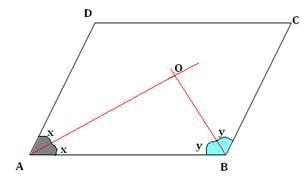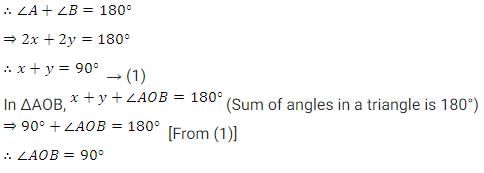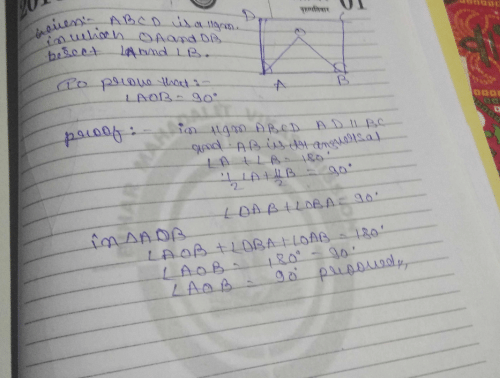Class 9 Exam > Class 9 Questions > In a parallelogram ABCD the bisector os the c...
Start Learning for Free
In a parallelogram ABCD the bisector os the consecutive angles A and B intesect at p show that angle APB=90�
?
?
Verified Answer
In a parallelogram ABCD the bisector os the consecutive angles A and B...

Given in parallelogram ABCD AO and BO are bisectors of angle A and angle B respectively.
We know that sum of adjacent angles in a parallelogram is 180degree

 This question is part of UPSC exam. View all Class 9 courses
This question is part of UPSC exam. View all Class 9 courses
Most Upvoted Answer
In a parallelogram ABCD the bisector os the consecutive angles A and B...

Community Answer
In a parallelogram ABCD the bisector os the consecutive angles A and B...
Proof that angle APB is 90° in a parallelogram ABCD:
1. Given Information:
- ABCD is a parallelogram.
- Angle APC bisects angle A.
- Angle BPD bisects angle B.
- The bisectors of consecutive angles A and B intersect at point P.
2. Property of Bisectors:
- The angle bisectors of a parallelogram divide the opposite sides into equal segments.
3. Proof:
- In parallelogram ABCD, angle APC and angle BPD divide sides AD and BC equally.
- Let AD = a, AP = x, PD = x, BC = b, PB = y, and PC = y.
- By angle bisector theorem, we have:
x/y = a/b (from triangle APD and triangle CPB)
- Since ABCD is a parallelogram, a = b.
- Therefore, x = y.
4. Conclusion:
- In triangle APB, we have AP = PB.
- This implies that triangle APB is an isosceles triangle with AP = PB.
- In an isosceles triangle, the angles opposite the equal sides are equal.
- Therefore, angle APB = angle PAB + angle PBA = 90° (since sum of angles in a triangle is 180°).
5. Therefore, angle APB is 90° in parallelogram ABCD.
Attention Class 9 Students!
To make sure you are not studying endlessly, EduRev has designed Class 9 study material, with Structured Courses, Videos, & Test Series. Plus get personalized analysis, doubt solving and improvement plans to achieve a great score in Class 9.

|
Explore Courses for Class 9 exam
|

|
Similar Class 9 Doubts
In a parallelogram ABCD the bisector os the consecutive angles A and B intesect at p show that angle APB=90�?
Question Description
In a parallelogram ABCD the bisector os the consecutive angles A and B intesect at p show that angle APB=90�? for Class 9 2024 is part of Class 9 preparation. The Question and answers have been prepared according to the Class 9 exam syllabus. Information about In a parallelogram ABCD the bisector os the consecutive angles A and B intesect at p show that angle APB=90�? covers all topics & solutions for Class 9 2024 Exam. Find important definitions, questions, meanings, examples, exercises and tests below for In a parallelogram ABCD the bisector os the consecutive angles A and B intesect at p show that angle APB=90�?.
In a parallelogram ABCD the bisector os the consecutive angles A and B intesect at p show that angle APB=90�? for Class 9 2024 is part of Class 9 preparation. The Question and answers have been prepared according to the Class 9 exam syllabus. Information about In a parallelogram ABCD the bisector os the consecutive angles A and B intesect at p show that angle APB=90�? covers all topics & solutions for Class 9 2024 Exam. Find important definitions, questions, meanings, examples, exercises and tests below for In a parallelogram ABCD the bisector os the consecutive angles A and B intesect at p show that angle APB=90�?.
Solutions for In a parallelogram ABCD the bisector os the consecutive angles A and B intesect at p show that angle APB=90�? in English & in Hindi are available as part of our courses for Class 9.
Download more important topics, notes, lectures and mock test series for Class 9 Exam by signing up for free.
Here you can find the meaning of In a parallelogram ABCD the bisector os the consecutive angles A and B intesect at p show that angle APB=90�? defined & explained in the simplest way possible. Besides giving the explanation of
In a parallelogram ABCD the bisector os the consecutive angles A and B intesect at p show that angle APB=90�?, a detailed solution for In a parallelogram ABCD the bisector os the consecutive angles A and B intesect at p show that angle APB=90�? has been provided alongside types of In a parallelogram ABCD the bisector os the consecutive angles A and B intesect at p show that angle APB=90�? theory, EduRev gives you an
ample number of questions to practice In a parallelogram ABCD the bisector os the consecutive angles A and B intesect at p show that angle APB=90�? tests, examples and also practice Class 9 tests.

|
Explore Courses for Class 9 exam
|

|
Suggested Free Tests
Test: The Fundamental Unit of Life- Case Based Type Questions- 1
Test | 10 questions
Signup for Free!
Signup to see your scores go up within 7 days! Learn & Practice with 1000+ FREE Notes, Videos & Tests.

























